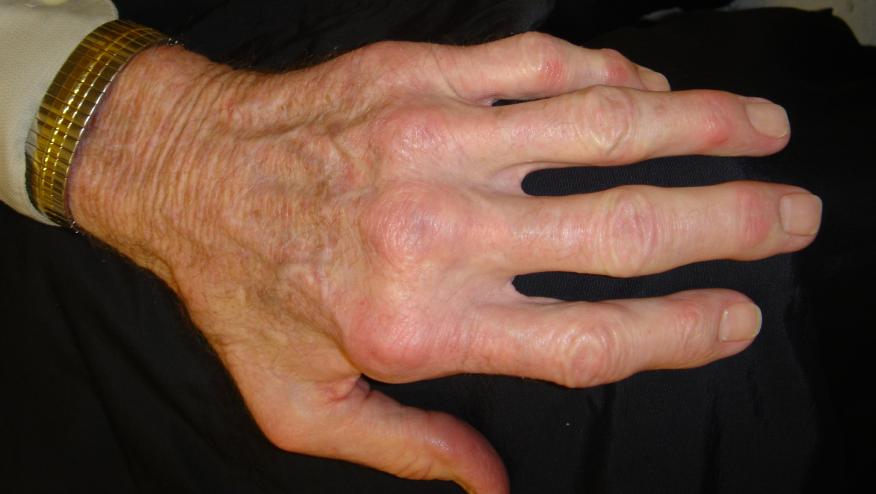What Factors Predict RA in First-Degree Relatives? Save

Among a cohort of first-degree relatives of patients with rheumatoid arthritis (RA), certain patient characteristics, as well as symptoms, helped predict a possible increased risk for developing the disease, U.K. researchers reported.
In a group of 870 first-degree relatives, 13.3% had the symmetrical and small joint pain that are typical of RA, according to Ian N. Bruce, MD, of the University of Manchester in England, and colleagues.
And on a multivariate regression analysis, patient characteristics that were associated with having both small and symmetrical joint pain included antibody positivity (OR 2.55, 95% CI 1.09-5.97), depression (OR 2.77, 95% CI 1.65-4.65), and older age (OR 1.04, 95% CI 1.02-1.07), the researchers reported online in Arthritis Research & Therapy.
RA is thought to result from a complex interplay of genetic and environmental factors. Patients who develop RA often have circulating autoantibodies long before the onset of symptoms, and studies have been exploring the possibility that this prodromal phase of disease might offer a window of opportunity for therapeutic intervention before the disease becomes manifest.
First-degree relatives of RA patients have a two- to four-fold higher risk of developing the disease compared with the general population, and therefore offer a potential source of insight into the preclinical phase of RA to identify factors that might help predict progression to clinical disease.
Accordingly, Bruce and colleagues analyzed data from the Preclinical Evaluation of Novel Targets in RA, a cohort of first-degree relatives of patients with established RA.
Participants completed a baseline questionnaire on demographics, lifestyle, and medical history and provided blood samples for detection of the RA-specific biomarkers rheumatoid factor (RF) and anti-cyclic citrullinated peptide (CCP), as well as the inflammatory marker C-reactive protein (CRP).
They also completed the Symptoms in Persons At Risk of Rheumatoid Arthritis (SPARRA) questionnaire, which collected information about joint pain, stiffness, and swelling, as well as emotional and concentration difficulties, sleep, and fatigue.
Factors that were considered a priori to be associated with higher risk of RA included symmetrical and small joint pain and swelling, seropositivity for RF or anti-CCP, and elevated CRP. Other potential contributors (based on previous literature) included age, sex, smoking, depression, body mass index, and education level. Analyses of symptoms were stratified according to seropositivity and CRP elevation.
Among the 870 participants, mean age was 51.8 years, three-quarters were women, and almost all were white.
About 19% reported depression, 15.4% were hypertensive, 5% were seropositive, and 14% had elevated CRP.
Symptoms that were reported most frequently included sleep disturbances in 20.3%, joint pain in 17.9%, and fatigue in 16.7%.
When stratified by seropositivity, a symptom that was significantly higher in seropositive patients was muscle cramping (23.8% vs 10.3%), and when stratified by CRP, symptoms that were more frequently reported were joint stiffness (20.7% vs 6%), difficulties in concentration (13.2% vs 6.9%), and sleep disturbances (31.4% vs 18.5%).
When the investigators looked at the patterns of joint symptoms, they found that large joint pain was present in 31%, small joint pain in 22.8%, and symmetrical joint pain in 17.1%.
When stratified by seropositivity, RF and/or anti-CCP positivity was more often associated with small joint pain (34.9% vs 22.1%) and symmetrical joint pain (27.9% vs 16.6%). When stratified by CRP level, associations were seen for symmetrical joint pain (27% vs 15.5%), small joint pain (32% vs 21.3%), and large joint pain (39.3% vs 29.7%).
Then, on a multivariate regression analysis, symptoms that were associated with increased risk specifically for both symmetrical and small joint pain -- and therefore for possibly developing RA -- were:
- Joint pain, OR 2.16 (95% CI 1.15-4.09)
- Joint stiffness, OR 3.0 (95% CI 1.50-6.0)
- Joint burning, OR 2.91 (95% CI 1.03-8.24)
- Joint tingling, OR 7.32 (95% CI 2.49-21.49)
- Fatigue, OR 2.03 (95% CI 1.06-3.89)
In this analysis, factors that were not associated with symmetrical and small joint pain included sleep and concentration difficulties, muscle cramps, and weakness.
In discussing their findings, the investigators noted that depression was "strongly associated" with symmetrical and small joint pain. However, depression was evaluated somewhat crudely, in just one question on the EuroQol-5D questionnaire, and should be further examined in more detail in future studies.
Limitations of the study included its cross-sectional design and the use of seropositivity as a proxy measure of clinical RA.
Source Reference: Costello RE, et al "Symptoms in first-degree relatives of patients with rheumatoid arthritis: evaluation of cross-sectional data from the symptoms in persons at risk of rheumatoid arthritis (SPARRA) questionnaire in the PRe-clinical EValuation of Novel Targets in RA (PREVeNT-RA) cohort" Arthritis Res Ther 2021; DOI: 10.1186/s13075-021-02593-w.









If you are a health practitioner, you may Login/Register to comment.
Due to the nature of these comment forums, only health practitioners are allowed to comment at this time.